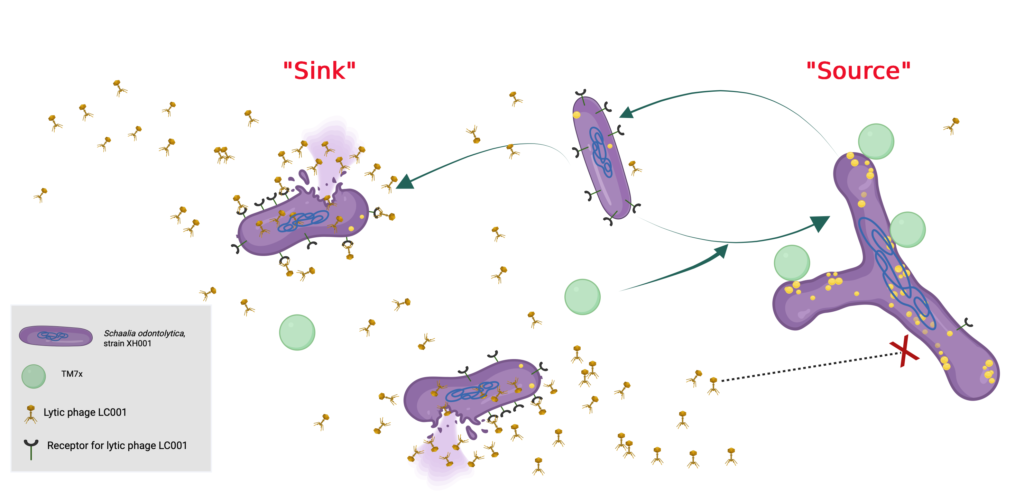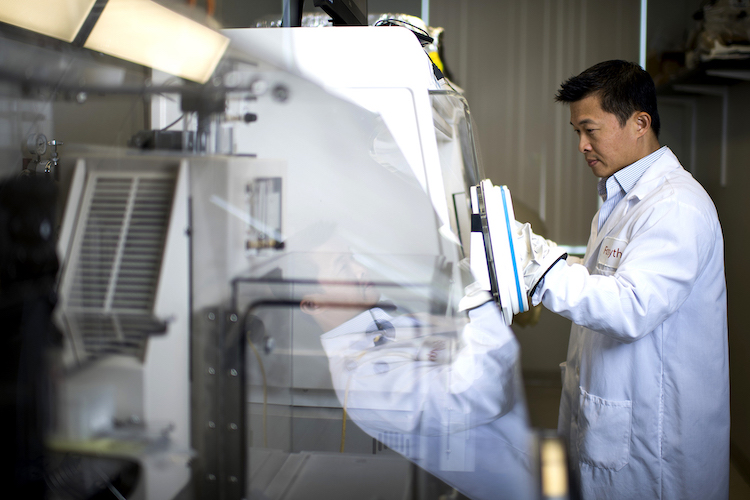Tripartite microbial interaction shows dynamic ecology promoting coexistence of antagonists in the oral microbiome
Media Contacts:
ADA Forsyth: Jill Sirko, jsirko@forsyth.org
ADA Media Relations: mediarelations@ada.org
Cambridge, Mass.: One of the most abundant and deadliest organisms on earth is a virus called a bacteriophage (phage). These predators have lethal precision against their targets – not humans, but bacteria. Different phages have evolved to target different bacteria and play a critical role in microbial ecology. Recently, ADA Forsyth scientists exploring the complex interactions of microbes in the oral microbiome discovered a third player influencing the phage-bacterial arms race – ultrasmall bacterial parasites, called Saccharibacteria or TM7.
In the study, which appeared in Proceedings of the National Academy of Sciences (PNAS), the scientists found that the nanosized epibiotic parasite, TM7x, helps its host bacterium (a Schaalia odontolytica strain called XH001) achieve resistance to lytic phages.
“Phage attacks and kills its prey bacterium XH001. However, when XH001 is parasitized by TM7x, it becomes resistant to phage infection,” said lead investigator Xuesong He, PhD, DDS, who is a Senior Member of Staff at the ADA Forsyth Institute (AFI). “Here, you have three members of the oral microbiome: a host, a parasite, and a predator. While the parasite may exploit the host bacteria for its own benefit, it helps the host protect itself against the predator. It is a very intriguing interaction within the human microbiome, and it is the first time this type of interaction has been documented.“
Most reported phage-resistance mechanisms involve mutations of phage receptors on the bacteria’s surface structures. Phages likewise have evolved counter-defensive genetic changes to adapt to these barriers. The parasite, in contrast, causes a physiological change to the host bacteria, which changes gene expression but not the genetic makeup of the bacteria. This change causes the gene to express differently, modulating the bacteria’s surface structures, which prevents the phages from attaching.
In a test tube, TM7x causes problems for the host bacteria, stressing it and reducing growth. However, when the organisms are in the oral cavity, which is a complex microbial ecosystem, the parasite becomes beneficial.
In this context, the TM7x ultimately helps the phage and bacteria to coexist by creating a sink-source dynamic: the bacteria without TM7x can continue to be available to the phage, while the bacteria with the parasite resist phages. These bacteria can continue to reproduce a supply for phage consumption while protecting themselves from the lytic phage by forming symbiotic relationship with TM7x.

This new understanding of the oral microbiome shows that the environment is very dynamic. As the environment changes, the relationship between microbes can change. “In terms of the oral ecology,” said Dr. He “there is no such thing as a bad bacteria or a bad microbe. They are just trying to survive. Whether it is good or bad is context dependent.”
Additional collaborators on the project included: Pu-Ting Dong, Batbileg Bor, Wenyuan Shi, and Lujia Cen from the ADA Forsyth Institute; Jeffrey S. McLean from the University of Washington; Yunjie Chang from Zhejiang University School of Medicine; Jun Liu from Yale University; Qiu Zhong, Jiazhen Liu, Jing Wang, and Shuai Le from Chongqing, Army Medical University; Binyou Liao, Miaomiao Wu, and Yan Li from Sichuan University; Wei Shen from Chongqing Medical University; Leilei Wei from Army Medical University, Chongqing; and Yansong Ma from the Capital University of Medicine.
This work was funded in part by: National Institute of Dental and Craniofacial Research of the NIH under awards 1R01DE023810 (to X.H., J.S.M., and W.S.) and R01DE030943 (to X.H.) and the National Natural Science Foundation of China (31870167 to S.L.).
Paper cited: “Episymbiotic Saccharibacteria TM7x modulates susceptibility of its host bacteria to phage infection and promotes their coexistence,” PNAS. DOI: 10.1073/pnas.2319790121

